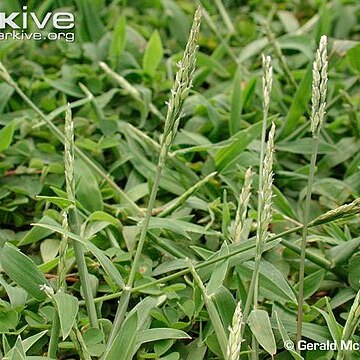An annual grass. The base is creeping and there are several slender stems. The nodes have beards. The leaf sheaths are shorter than the internodes. They are hairy and loose. The leaf blades are short and 5-8 mm wide. They are rounded at the base and have crinkly edges. The flower stalk has several slender racemes. The spikelets are arranged in an irregular fashion. They are less than 3 mm long.
Inflorescence ovate, of 5–15 closely spaced racemes, these 1–4 cm. long, bearing paired spikelets crowded on a triquetrous rhachis with hirsute pedicels.
Inferior glume short,1/8–1/4 length of spikelet, truncate (rarely a little longer and broadly ovate).
Culms 15–60 cm. high, usually decumbent and rooting at nodes.
Spikelets 1.5–2.2 mm. long, glabrous, acute.
Superior lemma rugose, mucronate.
Annual.


